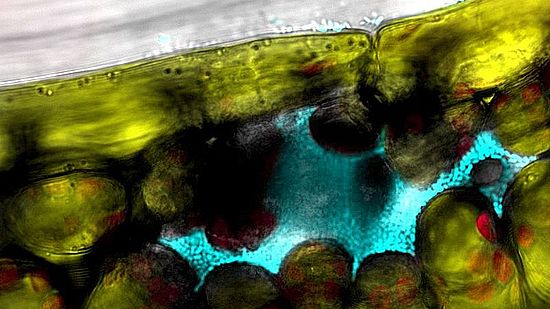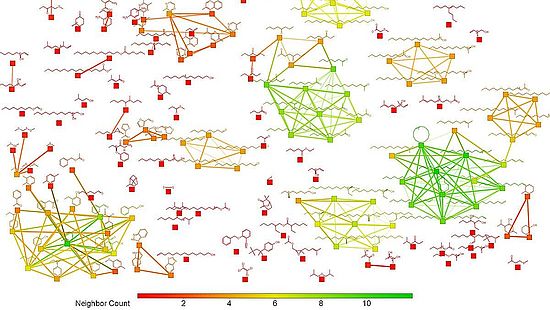Volatile organic compounds-mediated plant-microbe communication
Molecular Plant-Microbe Interactions
Unlike animals, plants do not possess olfactory receptors neither associated neural networks. However, plant cells do communicate via volatile organic compounds (VOCs) such as benzenoids, terpenoids and C6-aldehydes. The key defense-related phytohormones ethylene, methyl jasmonate and methyl salicylate are bona fide volatiles that trigger profound reprogramming of the plant transcriptome into an optimized growth/immune response trade-off.
Our research questions the role of bacteria-derived VOCs as signaling cues between microbes and plants. Bacterial VOCs bouquets comprise plant-like and microbe-specific molecules that elicit plant growth and systemic resistance. Yet, it remains unclear how plants perceive such molecules and distinguish bacterial cues from plant signals. The overlap between plant and microbial volatilomes suggests that VOCs constitute an ancient cross-kingdom language that allows the early recognition of compatible or incompatible partnerships.
Using the model plant Arabidopsis thaliana and pathogenic or beneficial rhizobacterial species, we intend to unravel the molecular pathways translating VOCs recognition into directed plant responses at the root interface.
Recent Publications
- Leaf nodule endosymbiotic Burkholderia confer targeted allelopathy to their Psychotria hosts
Georgiou, Antri; Sieber, Simon; Hsiao, Chien-Chi; Grayfer, Tatyana; Gorenflos Lopez, Jacob L.; Gademann, Karl; Eberl, Leo; Bailly, Aurelien
Scientific Reports 10.1038/s41598-021-01867-2 NOV 17 2021 - Metabolomics and Dual RNA-Sequencing on Root Nodules Revealed New Cellular Functions Controlled by Paraburkholderia phymatum NifA
Belles-Sancho, Paula; Lardi, Martina; Liu, Yilei; Eberl, Leo; Zamboni, Nicola; Bailly, Aurelien
Metabolites 10.3390/metabo11070455 JUL 2021 - Non-steroidal Anti-inflammatory Drugs Target TWISTED DWARF1-Regulated Actin Dynamics and Auxin Transport-Mediated Plant Development
Tan, Shutang; Di Donato, Martin; Glanc, Matous; Zhang, Xixi; Klima, Petr; Bailly, Aurelien; Ferro, Noel; Petrasek, Jan; Geisler, Markus; Friml, Jiri
Cell Reports, 10.1016/j.celrep.2020.108463 DEC 1 2020 - Auxin-transporting ABC transporters are defined by a conserved D/E-P motif regulated by a prolylisomerase
Hao, Pengchao; Xia, Jian; Liu, Jie; Di Donato, Martin; Pakula, Konrad; et al.
Journal Of Biological Chemistry DOI: 10.1074/jbc.RA120.014104 SEP 11 2020 - Linking Comparative Genomics of Nine Potato-Associated Pseudomonas Isolates With Their Differing Biocontrol Potential Against Late Blight
De Vrieze, Mout; Varadarajan, Adithi R.; Schneeberger, Kerstin; Bailly, Aurelien; Rohr, Rudolf P.; et al.
Frontiers In Microbiology DOI: 10.3389/fmicb.2020.00857 Published: APR 30 2020 - Synthesis and Biological Evaluation of the Novel Growth Inhibitor Streptol Glucoside, Isolated from an Obligate Plant Symbiont
Hsiao, CC; Sieber, S; Georgiou, A; Bailly, A; Emmanouilidou, D; Carlier, A; Eberl, L; Gademann, K
CHEMISTRY-A EUROPEAN JOURNAL, 25 (7):1722-1726; 10.1002/chem.201805693 FEB 1 2019 - Mining the Volatilomes of Plant-Associated Microbiota for New Biocontrol Solutions
Bailly, Aurelien; Weisskopf, Laure
FRONTIERS IN MICROBIOLOGY, 8; https://doi.org/10.3389/fmicb.2017.01638 AUG 25 2017 - TWISTED DWARF1 Mediates the Action of Auxin Transport Inhibitors on Actin Cytoskeleton Dynamics
Zhu, JS; Bailly, A; Zwiewka, M; Sovero, V; Di Donato, M; Ge, P; Oehri, J; Aryal, B; Hao, PC; Linnert, M; Burgardt, NI; Lucke, C; Weiwad, M; Michel, M; Weiergraber, OH; Pollmann, S; Azzarello, E; Mancuso, S; Ferro, N; Fukao, Y; Hoffmann, C; Wedlich-Soldner, R; Friml, J; Thomas, C; Geisler, M
PLANT CELL, 28(4): 930-948 10.1105/tpc.15.00726 APR 2016 - Master and servant: Regulation of auxin transporters by FKBPs and cyclophilins
Geisler, Markus; Bailly, Aurelien; Ivanchenko, Maria
PLANT SCIENCE 245: 1-10 DOI: 10.1016/j.plantsci.2015.12.004 APR 2016 - …

Dr. Aurélien Bailly
University of Zurich
Department of Plant and Microbial Biology
8008 Zurich
Tel: +41 (0)44 634 82 41
Links
Research topics
- Molecular plant-microbe interactions
- Induced systemic resistance in plants
- Plant growth- and health-promotion features of plant-associated bacteria
- Microbial volatile organic compounds
Interdisciplinary
- Chemical signaling in plants
- Innate immunity in plants
- Auxin-driven plant growth responses
- Microbiology
- Bio/chemistry of low molecular weight compounds


